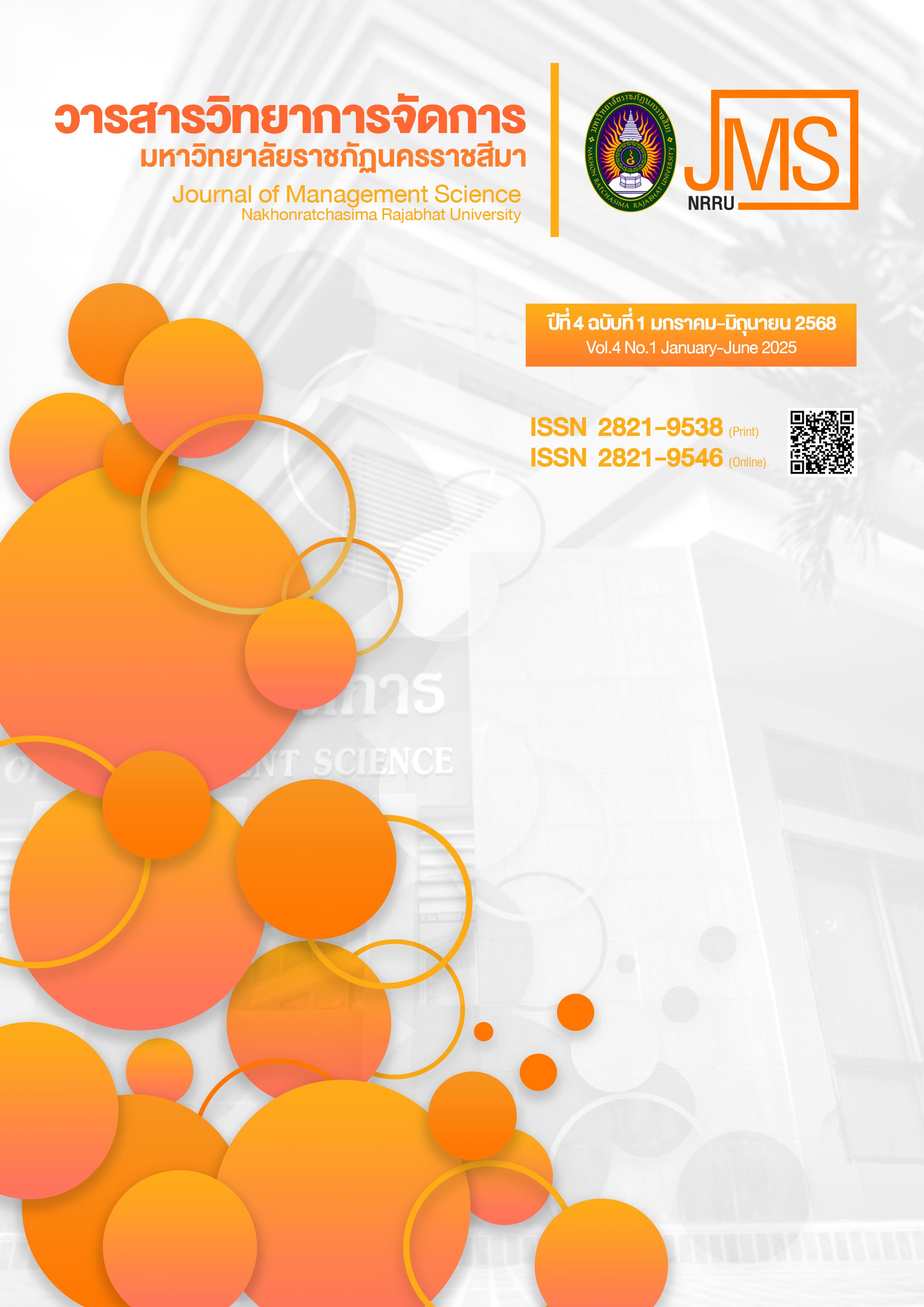Guidelines for Promoting Local Food Identity for Creative Gastronomic Tourism: A Case Study of Danchak sub-district, Nonthai district, Nakhonratchasima Province
Main Article Content
Abstract
This study was a qualitative research that aimed to explore the identity of local food for the purpose of promoting creative gastronomic tourism and to propose guidelines for enhancing local food identity in support of creative gastronomic tourism. The study was conducted as a case study of Danchak Sub-district, Nonthai District, Nakhon Ratchasima Province. The research employed a semi-structured interview form to collect data from 20 key informants, comprising
5 representatives from relevant government agencies and 15 local residents of Danchak
Sub-district, Nonthai district, Nakhonratchasima province
The findings revealed that Nam Tab represented the local food identity of Danchak
Sub-district, Nonthai district, Nakhonratchasima province and reflected the lifestyle and food culture of the community. The identity of this local cuisine encompassed 4 main dimensions:
1) Symbolic Dimension ; 2) Structural Dimension ; 3) Social Dimension; and (4) Spatial Dimension. The proposed guidelines for promoting local food identity to support creative gastronomic tourism included : 1) establishing local food entrepreneur groups to enhance collaboration and production capacity; 2) developing packaging to increase product appeal and market competitiveness;
3) promoting local food products to raise awareness among target customer groups, and
4) organizing training programs to enhance the quality and standards of local food products.
Article Details

This work is licensed under a Creative Commons Attribution-NonCommercial-NoDerivatives 4.0 International License.
บทความในวารสารเป็นลิขสิทธิ์ของวารสารวิทยาการจัดการ มหาวิทยาลัยราชภัฏนครราขสีมา
บทความที่ปรากฎในวารสารเป็นความคิดเห็นของผู้แต่งเพียงอย่างเดียวซึ่งไม่เกี่ยวข้องกับวารสาร
References
กติกา กลิ่นจันทร์แดง และศิริเพ็ญ ดาบเพชร. (2564). การพัฒนาการท่องเที่ยวเชิงวัฒนธรรมอาหารด้วย
อัตลักษณ์ของอาหารท้องถิ่น. วารสารชุมชนวิจัย. 15(3) : 144-157.
กรุงเทพธุรกิจ. (2561). ททท.ชวนส่งทริปกินใน 55 เมืองรองประกวดชิงรางวัลหลักล้าน. [ออนไลน์]. แหล่งที่มา : https://www.bangkokbiznews.com/pr-news/biz2u/244818. [20 มีนาคม 2565].
เกศณีย์ สัตตรัตนขจร, สนธิญา สุวรรณราช และกาญจนา คุมา. (2563). “การพัฒนาอาหารท้องถิ่นแบบมีส่วนร่วมเพื่อหนุนเสริมการท่องเที่ยวสร้างสรรค์เชิงวัฒนธรรมของจังหวัดลำปาง.” วารสารอารยธรรมศึกษา
โขง-สาละวิน. 11(1) : 152-173.
ณัฐกฤตา ศรีวิชัยโย. (2566). แนวทางการส่งเสริมการท่องเที่ยวเชิงสร้างสรรค์จังหวัดลำปาง. วิทยานิพนธ์
ศิลปศาสตรมหาบัณฑิต สาขาวิชาการจัดการการท่องเที่ยวและโรงแรม วิทยาลัยการจัดการ มหาวิทยาลัยพะเยา.
ธนภูมิ อติเวทิน. (2552). พัฒนาการของการท่องเที่ยวเพื่อรับประทานอาหารในประเทศไทย. วารสารศิลปกรรมศาสตร์ มหาวิทยาลัยศรีนครินทรวิโรฒ. 30(1) : 38-57.
พรรณี สวนเพลง และคณะ. (2559). การท่องเที่ยวเชิงอาหาร. รายงานภาวะเศรษฐกิจท่องเที่ยว. 4(2) : 38-45.
มณีกาญจน เขียวรัตน์ และคณะ. (2564). “ศักยภาพอาหารท้องถิ่นเพื่อสร้างความได้เปรียบด้านการท่องเที่ยว
เขตอำเภอเมือง จังหวัดอุบลราชธานี.” วารสารบัณฑิตวิทยาลัย มหาวิทยาลัยราชภัฏอุบลราชธานี. 16(3) : 191-203.
ยุทธศักดิ์ สุภสร. (2560). “การนําเสนอทิศทางการส่งเสริมการท่องเที่ยวของททท. ปี 2561.” จุลสารวิชาการ
การท่องเที่ยว การท่องเที่ยวแห่งประเทศไทย. [ออนไลน์]. 3(4) : 60-67. แหล่งที่มา https:// tatreviewmagazine.com/e_magazine/vol-3-no-4-october-december-2017/. [20 มีนาคม 2565].
วริศ เชาวนศิลป์ และเจริญชัย เอกมาไพศาล. (2565). “การท่องเที่ยวเชิงอาหารในประเทศไทยภายใต้การระบาดของโรคโควิด-19.” วารสารธรรมศาสตร์. 41(3) : 116-138.
สุดารัตน์ ชามาตร, ปารีรัตน์ อุ่นชัย และชนกพร จักรชุม. (2567). “การรับรู้อาหารท้องถิ่นของนักท่องเที่ยวชาวไทยในจังหวัดนครพนม.” วารสารมนุษยสังคมศาสตร์. 2(1) : 37-52.
สุนี ศักดาเดช. (2549). อาหารท้องถิ่น. เชียงใหม่ : มหาวิทยาลัยเชียงใหม่.
เสาวภา ศักยพันธ์. (2548). อาหารท้องถิ่น. เชียงใหม่ : คณะวิทยาศาสตร์และเทคโนโลยี มหาวิทยาลัยราชภัฏเชียงใหม่.
เสรี วงษ์มณฑา. (2564). การท่องเที่ยวเชิงสร้างสรรค์: นวัตกรรมการเคลื่อนขยับของการท่องเที่ยวเชิงวัฒนธรรม. วารสารศิลปศาสตร์ (วังนางเลิ้ง) มหาวิทยาลัยเทคโนโลยีราชมงคลพระนคร. 1(1) : 1-24.
สำนักงานวัฒนธรรมจังหวัดนครราชสีมา. (ม.ป.ป.) . อาหารพื้นเมือง. [ออนไลน์]. แหล่งที่มา : https:// nakhonratchasima.m-culture.go.th/th/db_72_nakhonratchasima_9. [6 มิถุนายน 2568].
Bessière, J. (1998). Local Development and Heritage: Traditional Food and Cuisine as Tourist Attractions in Rural Areas. Sociologia Ruralis. 38(1) : 21-34.
Hall, M. (2005). Rural Wine and Food Tourism Cluster and Network Development. In Rural tourism and sustainable business. Bristol: Channel View Publications Ltd.
Hall, M., & Sharples, L. (2003). The consumption of experiences or the experience of consumption? An introduction to the tourism of taste. In M. Hall, L. Sharples, R. Mitchell, N. Macionis & B. Cambourne (Eds.), Food Tourism Around the World development, management and markets (pp. 1-24). oxford: Butterworth-Heinemann.
Hegarty, J. A., & O’Mahony, G. B. (2001). Gastronomy: A phenomenon of cultural expressionism and an aesthetic for living. International Journal of Hospitality Management. 20(1) :
-13.
Lincoln, Y. S., & Guba, E. G. (1985). Naturalistic inquiry. California: Sage Publications.
Richards, G., & Raymond, C. (2000). Creative Tourism. ATLAS News. (23) : 16-20.
Wolf, E. (2002). Culinary Tourism: A Tasty Economic Proposition. International Culinary Tourism Task Force.


